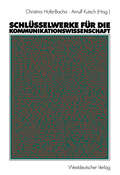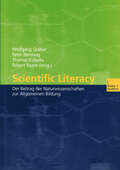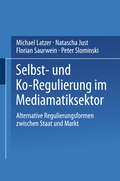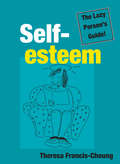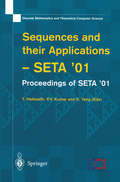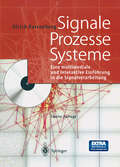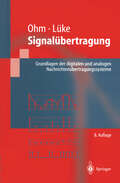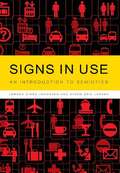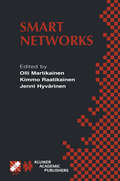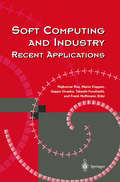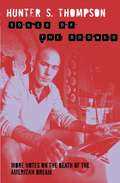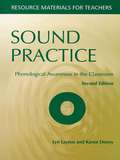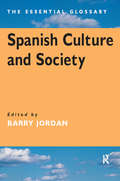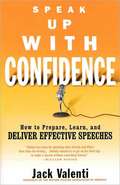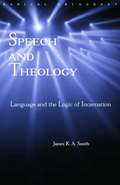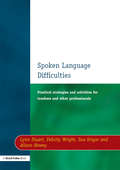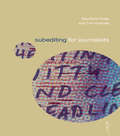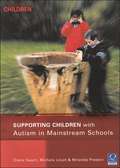- Table View
- List View
Schlüsselwerke für die Kommunikationswissenschaft
by Christina Holtz-Bacha Arnulf KutschIn diesem Lehrbuch werden ca. 200 zentrale und wegweisende Werke für die Kommunikationswissenschaft vorgestellt. Jeder Beitrag enthält nach einheitlichem Muster eine informative Beschreibung der Entstehung und des Gehalts des jeweiligen Hauptwerks. Zusätzlich werden zu jedem Werk Originaltitel, ggf. deutsche Übersetzungen und die Standardsekundärliteratur genannt. Abgeschlossen wird das Lehrbuch durch ein Schlagwort- und ein Werkregister. Somit ist dieser Band ein unentbehrliches Hilfsmittel, um sich über die Geschichte und die zentralen wissenschaftlichen Erkenntnisse für die Kommunikationswissenschaft zu informieren.
Scientific Literacy: Der Beitrag der Naturwissenschaften zur Allgemeinen Bildung
by Wolfgang Gräber Peter Nentwig Thomas R. Koballa Robert H. EvansNaturwissenschaftliche Bildung steht spätestens seit den Ergebnissen von TIMSS und PISA auch in Deutschland auf dem Prüfstand. Die Ziele werden vielfach unter dem Begriff "Scientific Literacy" diskutiert, der aus dem angelsächsischen Sprachraum stammt und mit "naturwissenschaftliche Grundbildung" nur unzureichend zu übersetzen ist. Namhafte Fachdidaktiker aus Deutschland, der Schweiz und den USA beschreiben dieses Konstrukt aus unterschiedlichen Perspektiven - Verfechter und Kritiker kommen gleichermaßen zu Wort.
Selbst- und Ko-Regulierung im Mediamatiksektor: Alternative Regulierungsformen zwischen Staat und Markt
by Michael Latzer Natascha Just Florian Saurwein Peter SlominskiDieses Buch analysiert theoretische Probleme der Selbst- und Ko-Regulierung im Kommunikationsbereich. Eine erstmals umfassende empirische Untersuchung der alternativen Regulierungsinstitutionen des österreichischen Mediamatiksektors lässt auch Rückschlüsse auf Wirkungsbereiche, Steuerungsziele und die neue Aufgabenverteilung zwischen privaten und staatlichen Akteuren für andere Länder zu.
Self-esteem: Quick and Simple Ways to Change How You Feel About Yourself (The\lazy Person's Guide! Ser.)
by Theresa Francis-CheungChange how you think and feel about yourself – and change your life.You’ve had a glance at the vast array of self-esteem books on the shelves and been thoroughly daunted. It all seems so complicated. You don’t have time to wade through pages and pages of technical jargon, therapeutic approaches, discussions, case studies or quizzes. You don’t want to have to take up yoga or tai chi, let alone swim with dolphins or nurture your inner child. You just want to feel better about yourself – and fast!Enter The Lazy Person’s Guide! In no time at all this little guide will help you understand and improve the way you think and feel about yourself. It will give you all the essential information and advice you need and will help you change your life for the better, right now.The Lazy Person's Guide! is a series of popular, cheerful yet thoroughly grounded, practical and authoritative books on various health issues and conditions. Other titles in the series include Beating Overeating, Detox, Exercise, Improving Your Memory, Midlife, Quitting Smoking and Stress. Self-esteem: The Lazy Person’s Guide!: Table of ContentsPART ONE: Self-EsteemSelf-esteemDo you have it?Why haven’t you got it?How can you get it?PART TWO: Eight Secrets to Better Self-EsteemGet to know yourselfDon’t believe it because you think itManage your emotionsImprove your communication skillsMake decisionsTake care of yourselfManage stressEnjoy yourselfPART THREE: Extra HelpExtra help, if you need itConfidence-boosting tipsAfterword
Sequences and their Applications: Proceedings of SETA ’01 (Discrete Mathematics and Theoretical Computer Science)
by T. Helleseth P. V. Kumar K. YangPseudorandom sequences have widespread applications, for instance, in spread spectrum, code division multiple access, optical and ultrawide band communication systems, as well as in ranging systems global positioning systems, circuit testing and stream ciphers. Such sequences also have strong ties to error-correcting codes.This volume contains survey and research papers on sequences and their applications. It brings together leading experts from discrete mathematics, computer science and communications engineering, and helps to bridge advances in these different areas. Papers in this volume discuss the theory of sequences and their applications in cryptography, coding theory, communications systems, numerical computation and computer simulation.
Signale - Prozesse - Systeme: Eine multimediale und interaktive Einführung in die Signalverarbeitung
by Ulrich KarrenbergBuch und CD-ROM bilden ein Lernsystem, welches selbst erforschendes Lernen und die Visualisierung komplexer Vorgänge möglich macht. Das zugrunde liegende didaktische Konzept setzt auf die Visualisierung von Signalen und Prozessen sowie auf die grafische Programmierung signaltechnischer Systeme.
Signalübertragung: Grundlagen der digitalen und analogen Nachrichtenübertragungssysteme (Springer-Lehrbuch)
by Jens Ohm Hans Dieter LükeDieses Standardlehrbuch der Signalübertragung ist auch in der 8., neubearbeiteten Auflage eine grundlegende Einführung in die Theorie der Nachrichtenübertragung. Studenten der Elektrotechnik und der Physik sowie Praktikern aus Industrie und Forschung vermittelt dieses didaktisch hervorragend konzipierte und bewährte Lehrbuch das benötigte Wissen. Dabei orientiert sich die 8. Auflage an den aktuellen Entwicklungen: Methoden der digitalen Signalverarbeitung, Verfahren der digitalen Modulation sowie aktuelle Multiplexverfahren, wie z.B. Codemultiplex und OFDM werden gegenüber der Vorauflage vertieft behandelt. Ergänzende Themenaufgaben mit ausführlichen Lösungen sowie ein auf den aktuellen Stand gebrachtes Verzeichnis weiterführender Literatur runden das Buch ab, das jetzt im handlicheren Format vorliegt. Die Autoren bieten im Internet Lösungen zu allen im Buch gestellten Aufgaben an.
Signs in Use: An Introduction to Semiotics
by Jørgen Dines Johansen Svend Erik LarsenSigns in Use is an accessible introduction to the study of semiotics.All organisms, from bees to computer networks, create signs, communicate, and exchange information. The field of semiotics explores the ways in which we use these signs to make inferences about the nature of the world.Signs in Use cuts across different semiotic schools to introduce six basic concepts which present semiotics as a theory and a set of analytical tools: code, sign, discourse, action, text, and culture. Moving from the most simple to the most complex concept, the book gradually widens the semiotic perspective to show how and why semiotics works as it does.Each chapter covers a problem encountered in semiotics and explores the key concepts and relevant notions found in the various theories of semiotics. Chapters build gradually on knowledge gained, and can also be used as self-contained units for study when supported by the extensive glossary. The book is illustrated with numerous examples, from traffic systems to urban parks, and offers useful biographies of key twentieth-century semioticians.
Signs in Use: An Introduction to Semiotics
by Jørgen Dines Johansen Svend Erik LarsenSigns in Use is an accessible introduction to the study of semiotics.All organisms, from bees to computer networks, create signs, communicate, and exchange information. The field of semiotics explores the ways in which we use these signs to make inferences about the nature of the world.Signs in Use cuts across different semiotic schools to introduce six basic concepts which present semiotics as a theory and a set of analytical tools: code, sign, discourse, action, text, and culture. Moving from the most simple to the most complex concept, the book gradually widens the semiotic perspective to show how and why semiotics works as it does.Each chapter covers a problem encountered in semiotics and explores the key concepts and relevant notions found in the various theories of semiotics. Chapters build gradually on knowledge gained, and can also be used as self-contained units for study when supported by the extensive glossary. The book is illustrated with numerous examples, from traffic systems to urban parks, and offers useful biographies of key twentieth-century semioticians.
Silicon Literacies: Communication, Innovation and Education in the Electronic Age (Literacies)
by Ilana SnyderElectronic communication is radically altering literacy practices. Silicon Literacies unravels the key features of the new communication order to explore the social, cultural and educational impact of silicon literacy practices.Written by leading international scholars from a range of disciplines, the essays in this collection examine the implications of text produced on a keyboard, visible on a screen and transmitted through a global network of computers. The book covers topics as diverse as role-playing in computer games, the use of graphic symbols in on-screen texts and Internet degree programmes to reveal that being literate is to do with understanding how different modalities combine to create meaning.Recognizing that reading and writing are only part of what people have to learn to be literate, the contributors enhance our understanding of the ways in which the use of new technologies influence, shape and sometimes transform literacy practices.
Silicon Literacies: Communication, Innovation and Education in the Electronic Age (Literacies)
by Ilana SnyderElectronic communication is radically altering literacy practices. Silicon Literacies unravels the key features of the new communication order to explore the social, cultural and educational impact of silicon literacy practices.Written by leading international scholars from a range of disciplines, the essays in this collection examine the implications of text produced on a keyboard, visible on a screen and transmitted through a global network of computers. The book covers topics as diverse as role-playing in computer games, the use of graphic symbols in on-screen texts and Internet degree programmes to reveal that being literate is to do with understanding how different modalities combine to create meaning.Recognizing that reading and writing are only part of what people have to learn to be literate, the contributors enhance our understanding of the ways in which the use of new technologies influence, shape and sometimes transform literacy practices.
Smart Networks: IFIP TC6 / WG6.7 Seventh International Conference on Intelligence in Networks (SmartNet 2002) April 8–10, 2002, Saariselkä, Lapland, Finland (IFIP Advances in Information and Communication Technology #84)
by JenniHyvärinen KimmoRaatikainen OlliMartikainenSmart Networks comprises the proceedings of Smartnet'2002, the seventh conference on Intelligence in Networks, which was sponsored by the International Federation for Information Processing (IFIP) and organized by Working Group 6.7. It was held in Saariselkä, Finland, in April 2002. The conference series closely reflects the developments in networking.
Soft Computing and Industry: Recent Applications
by Rajkumar Roy Seppo Ovaska Takeshi Furuhashi Frank Hoffmann Mario KöppenSoft computing embraces various methodologies for the development of intelligent systems that have been successfully applied to a large number of real-world problems. Soft Computing in Industry contains a collection of papers that were presented at the 6th On-line World Conference on Soft Computing in Industrial Applications that was held in September 2001. It provides a comprehensive overview of recent theoretical developments in soft computing as well as of successful industrial applications. It is divided into seven parts covering material on: keynote papers on various subjects ranging from computing with autopoietic systems to the effects of the Internet on education; intelligent control; classification, clustering and optimization; image and signal processing; agents, multimedia and Internet; theoretical advances; prediction, design and diagnosis. The book is aimed at researchers and professional engineers who develop and apply intelligent systems in computer engineering.
Songs of the Doomed: More Notes on the Death of the American Dream (Gonzo Papers #Vol. 3)
by Hunter Thompson'I was thinking; my mind was running at top speed, scanning and sorting my options. They ranged all the way from Dumb and Dangerous to Crazy, Evil, and utterly wrong from the start . . . stand back. We are on the brink. Yes. I have an idea.' When Hunter S. Thompson has an idea, you just have to listen – and he shares many of his unique ideas in this collection of journalism, social commentary, short fiction and autobiography. Divided into sections by decade, Songs of the Doomed begins with a furious condemnation of the US justice system and ends with the author’s own version of the events that led to his extraordinary court case. Stopping off at the infamous summit conference in Elko, Illinois; Saigon in 1975 (the war zone Thompson was fired while en route to); and Palm Beach in the eighties for the Pulitzer divorce, here – in true Gonzo fashion – is the long strange trip from Kennedy to Nixon to Quayle. ‘Mr Thompson’s best work of the past three decades’ New York Times Book Review ‘There are many hideously funny stories in this collection. Thompson writing on mescalin, staying on for the fall of Saigon, explaining what it must be like to be a multimillionaire in Palm Beach . . .’ Independent on Sunday ‘Dead funny . . . That our guru has made it this far merits drinks and dynamite all round at the Woody Creek Road and Gun Club (and spiritually affiliated North London branches). That he is still alive, and at large, defies medical and legal beliefs’ Andy Kershaw, Literary Review ‘Proves that you can’t keep the old bastard quiet . . . a superb offering’ City Limits
Sound Practice: Phonological Awareness in the Classroom
by Lyn Layton Karen DeenyThe second edition of Sound Practice looks afresh at how young children can be helped to discover basic facts about an alphabetic spelling system, within the context of their developing spoken language. It examines why children might fail to understand letter-sound links; the origins of severe and persistent difficulties with achieving functional literacy skills; and developmental processes underpinning the areas of learning identified in national initiatives for promoting children's learning. The book also discusses the need for differentiation strategies to respond to individual children's learning needs within national initiatives, and techniques and approaches that can be effectively applied to fulfil curriculum objectives. Phonological awareness is the key to independent literacy and must be explicitly tackled in the classroom in order to promote early reading and writing and to address written language difficulties in older children. This book is a suitable resource for initial and in-service training for teachers and teaching assistants and includes photocopiable worksheets.
Sound Practice: Phonological Awareness in the Classroom (Resource Materials For Teachers Ser.)
by Lyn Layton Karen DeenyThe second edition of Sound Practice looks afresh at how young children can be helped to discover basic facts about an alphabetic spelling system, within the context of their developing spoken language. It examines why children might fail to understand letter-sound links; the origins of severe and persistent difficulties with achieving functional literacy skills; and developmental processes underpinning the areas of learning identified in national initiatives for promoting children's learning. The book also discusses the need for differentiation strategies to respond to individual children's learning needs within national initiatives, and techniques and approaches that can be effectively applied to fulfil curriculum objectives. Phonological awareness is the key to independent literacy and must be explicitly tackled in the classroom in order to promote early reading and writing and to address written language difficulties in older children. This book is a suitable resource for initial and in-service training for teachers and teaching assistants and includes photocopiable worksheets.
Spanish Culture and Society: The Essential Glossary (The\essential Glossary Ser.)
by Barry JordanFirst published in 2002. Routledge is an imprint of Taylor & Francis, an informa company.
Speak Up with Confidence: How to Prepare, Learn, and Deliver Effective Speeches (Playaway Adult Nonfiction Ser.)
by Jack ValentiPublic speaking is one of the most intimidating and important aspects of many jobs. As a one-time speechwriter for President Johnson, and in his current position as president of the Motion Picture Association of America, Jack Valenti has written and delivered speeches in all kinds of settings. Originally published in 1982, Speak Up with Confidence is an indispensable resource for anyone who wants to write and deliver a speech that people will listen to and remember.
Speech and Theology: Language and the Logic of Incarnation (Routledge Radical Orthodoxy)
by James K.A. SmithGod is infinite, but language finite; thus speech would seem to condemn Him to finitude. In speaking of God, would the theologian violate divine transcendence by reducing God to immanence, or choose, rather, to remain silent? At stake in this argument is a core problem of the conditions of divine revelation. How, in terms of language and the limitations of human understanding, can transcendence ever be made known? Does its very appearance not undermine its transcendence, its condition of unknowability?Speech and Theology posits that the paradigm for the encounter between the material and the divine, or the immanent and transcendent, is found in the Incarnation: God's voluntary self-immersion in the human world as an expression of His love for His creation. By this key act of grace, hinged upon Christs condescension to human finitude, philosophy acquires the means not simply to speak of perfection, which is to speak theologically, but to bridge the gap between word and thing in general sense.
Speech and Theology: Language and the Logic of Incarnation (Routledge Radical Orthodoxy)
by James K.A. SmithGod is infinite, but language finite; thus speech would seem to condemn Him to finitude. In speaking of God, would the theologian violate divine transcendence by reducing God to immanence, or choose, rather, to remain silent? At stake in this argument is a core problem of the conditions of divine revelation. How, in terms of language and the limitations of human understanding, can transcendence ever be made known? Does its very appearance not undermine its transcendence, its condition of unknowability?Speech and Theology posits that the paradigm for the encounter between the material and the divine, or the immanent and transcendent, is found in the Incarnation: God's voluntary self-immersion in the human world as an expression of His love for His creation. By this key act of grace, hinged upon Christs condescension to human finitude, philosophy acquires the means not simply to speak of perfection, which is to speak theologically, but to bridge the gap between word and thing in general sense.
Spoken Language Difficulties: Practical Strategies and Activities for Teachers and Other Professionals
by Lynn Stuart Felicity Wright Sue Grigor Alison HoweyIntended as a practical approach to helping children who have spoken language difficulties because of general language delay or specific language impairment, this book contains ideas and activity sheets as well as structured guidance. Areas of language difficulty are identified, activities are suggested to meet these language needs and all this is supported by a developmental framework. This book also provides advice on classroom management and grouping, in addition to a bank of individual targets for IEPs which are linked to the activities and strategies suggested within the book. Suitable for non-specialists and specialists alike, many professionals find this book to be an invaluable resource, including mainstream teachers, teaching assistants, speech and language therapists working in schools, SENCOs, nursery nurses and special school teachers.
Spoken Language Difficulties: Practical Strategies and Activities for Teachers and Other Professionals
by Lynn Stuart Felicity Wright Sue Grigor Alison HoweyIntended as a practical approach to helping children who have spoken language difficulties because of general language delay or specific language impairment, this book contains ideas and activity sheets as well as structured guidance. Areas of language difficulty are identified, activities are suggested to meet these language needs and all this is supported by a developmental framework. This book also provides advice on classroom management and grouping, in addition to a bank of individual targets for IEPs which are linked to the activities and strategies suggested within the book. Suitable for non-specialists and specialists alike, many professionals find this book to be an invaluable resource, including mainstream teachers, teaching assistants, speech and language therapists working in schools, SENCOs, nursery nurses and special school teachers.
Subediting and Production for Journalists: Print, Digital & Social
by Wynford Hicks Tim HolmesSubediting for Journalists is a concise, up-to-date and readable introduction to the skills of subediting for newspapers and magazines. It describes how subediting has developed, from the early days of printing to the modern era of computers and the web, and explains clearly what the sub now has to do.Using practical examples from newspapers and magazines, Subediting for Journalists introduces the various techniques involved in subediting from cutting copy to writing cover lines. It includes:*house style explained with model stylebook provided*examples of bad journalistic English such as misused clichés and pronoun confusion*subbing news and features for sense and style*editing quotes and readers' letters*projecting copy by writing headlines and standfirsts*checking pictures and writing captions*principles and methods of proofreading*making copy legally safe*understanding production and using software packages *website subbing*a glossary of journalistic terms and suggestions for further reading
Subediting and Production for Journalists: Print, Digital & Social
by Wynford Hicks Tim HolmesSubediting for Journalists is a concise, up-to-date and readable introduction to the skills of subediting for newspapers and magazines. It describes how subediting has developed, from the early days of printing to the modern era of computers and the web, and explains clearly what the sub now has to do.Using practical examples from newspapers and magazines, Subediting for Journalists introduces the various techniques involved in subediting from cutting copy to writing cover lines. It includes:*house style explained with model stylebook provided*examples of bad journalistic English such as misused clichés and pronoun confusion*subbing news and features for sense and style*editing quotes and readers' letters*projecting copy by writing headlines and standfirsts*checking pictures and writing captions*principles and methods of proofreading*making copy legally safe*understanding production and using software packages *website subbing*a glossary of journalistic terms and suggestions for further reading
Supporting Children with Autism in Mainstream Schools (Supporting Children)
by Diana Seach Michele Lloyd Miranda PrestonIt is increasingly common for children with autism to attend mainstream schools. In this book, the authors use their expertise and considerable experience of working with and observing pupils with autism to exemplify the challenges faced in the classroom. Most importantly, they suggest practical strategies for successfully meeting pupil's learning needs. The case studies bring to life the everyday concerns of young people, their parents and teachers, and provide different contexts for the demonstration of good practice.
